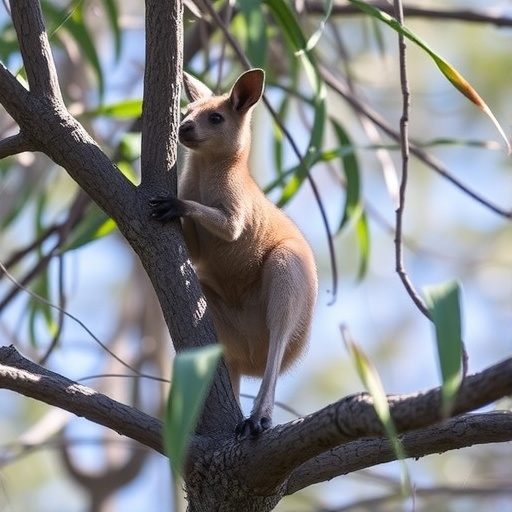In a groundbreaking revelation from Australia, ecologists studying the elusive Kangaroo Island dunnart, an endangered marsupial native to the isolated ecosystem of Kangaroo Island, have uncovered a surprising aspect of its behavior: its partial arboreality. Previously, the scientific community widely regarded the small carnivorous dunnart as strictly terrestrial, navigating the underbrush and ground-level habitats of its environment. However, new evidence challenges this long-held assumption, demonstrating that this species possesses the ability to climb and utilize arboreal spaces, including sheltering in tree hollows.
This discovery emerged from observations within the Kangaroo Island Nest Box Project, an extensive citizen science initiative designed to aid in post-bushfire wildlife recovery while systematically investigating nesting behaviors of various native species. The project employed artificial nest boxes originally intended for pygmy-possums—small arboreal marsupials—to attract and monitor fauna returning to fire-affected habitats. Unexpectedly, researchers documented the Kangaroo Island dunnart occupying these raised nest boxes affixed to mallee eucalyptus trees. This behavior contradicts earlier notions that the dunnart was confined to terrestrial shelter use, markedly expanding our understanding of its ecological niche.
The team, led by Associate Professor Sophie Petit from the University of South Australia and Peter Hammond of the Kangaroo Island Research Station, utilized long-term observational methodologies by monitoring hundreds of artificial hollows installed after the disastrous 2019–2020 Black Summer bushfires. These fires devastated nearly half of Kangaroo Island’s ecosystems, obliterating 98% of the dunnart’s original habitat and raising urgent concerns about their survival. The nest boxes were strategically positioned with the aim to support recolonization and provide critical data on species’ nesting ecology in an environment undergoing rapid regeneration.
Between 2022 and 2025, multiple confirmed sightings occurred of the dunnart occupying these nest boxes situated several meters above ground level. One particularly compelling observation recorded the marsupial resting atop a bed of finely shredded wood within a box, implying active nest construction behavior likely intended to enhance thermal regulation and comfort. This use of arboreal refuges not only indicates behavioral plasticity but also suggests an adaptive response possibly catalyzed by habitat loss pressures, highlighting the species’ capacity for ecological resilience under extreme environmental stress.
The significance of these findings extends beyond the dunnart itself, shedding light on the critical role that tree hollows play in maintaining biodiversity within eucalypt woodlands and mallee habitats. Tree hollows are well recognized as essential microhabitats for a multitude of endemic Australian fauna, including birds, bats, and various marsupials. The incorporation of the dunnart into this arboreal niche underscores the complex interspecific interactions that govern shelter competition and resource partitioning in these environments. Such insights are vital for conservation strategies tailored not only to preserve individual species but to uphold broader ecosystem integrity.
While artificial nest boxes serve as valuable tools for wildlife monitoring and refuge provision, the research team acknowledges associated risks intrinsic to their use. These include increased predation pressure as artificial hollows may inadvertently concentrate predators and prey, as well as intensified competition among hollow-dependent species for limited nesting sites. Understanding these dynamics through continued observation will be crucial for optimizing nest box design, placement, and management to minimize negative impacts while maximizing benefits for threatened species like the Kangaroo Island dunnart.
The collective effort of scientists, local landholders, and community volunteers has been instrumental in the success of the Kangaroo Island Nest Box Project, which was recognized as a finalist for the prestigious 2024 Australian Museum Eureka Prize for Innovation in Citizen Science. This collaboration embodies a model for engaging diverse stakeholders in scientific research and conservation, combining grassroots environmental stewardship with rigorous academic inquiry. Such partnerships are increasingly important in addressing the multifaceted challenges presented by climate change and anthropogenic habitat alteration.
Assoc. Prof. Petit emphasizes that this discovery marks a significant progression in understanding a poorly known species with high conservation priority. The revelation that the dunnart is partially arboreal opens avenues for future research into its life history traits, habitat requirements, and ecological interactions. Such data are imperative for refining management plans aimed at promoting population recovery and mitigating extinction risks following catastrophic environmental disturbances.
Further investigations will focus on detailed behavioral studies, microhabitat preferences, and interspecific interactions within nest boxes. The goal is to unravel the complexity of biodiversity dynamics in hollow-using fauna, addressing questions regarding species coexistence and the functional importance of arboreal refuges in fire-impacted landscapes. These findings advocate for integrating arboreal conservation measures into broader ecosystem restoration initiatives.
As Kangaroo Island continues its gradual recovery from the Black Summer fires, the resilience displayed by its unique fauna, including the Kangaroo Island dunnart, is a testament to the adaptive capacities of native wildlife when supported by targeted conservation interventions. The discovery that a species once considered ground-dwelling can exploit tree hollows elevates the ecological significance of such habitats and strengthens the rationale for protecting and restoring hollow-bearing trees throughout Australia’s fire-prone regions.
The pioneering work reported in Pacific Conservation Biology offers a striking example of how combining citizen science with scientific rigor generates impactful ecological insights. It highlights the critical role of long-term monitoring and adaptive management in conserving species on the brink of extinction and preserving the intricate fabric of Australia’s natural heritage.
Subject of Research:
Animals
Article Title:
Endangered Kangaroo Island dunnarts are partially arboreal and use pygmy-possum nest boxes
News Publication Date:
7-Oct-2025
Web References:
http://dx.doi.org/10.1071/PC25057
References:
Petit, S., Hammond, P. (2025). Endangered Kangaroo Island dunnarts are partially arboreal and use pygmy-possum nest boxes. Pacific Conservation Biology. DOI: 10.1071/PC25057
Image Credits:
University of South Australia
Keywords:
Endangered species, Animal science, Carnivores, Wildlife
Tags: citizen science wildlife recoveryconservation of Kangaroo Island wildlifeecological niche of Kangaroo Island speciesendangered marsupials Australiainnovative wildlife observation methodsKangaroo Island dunnart behaviormallee eucalyptus ecosystemnesting behavior of marsupialspartial arboreality in dunnartspost-bushfire fauna monitoringresearch on arboreal marsupialstree hollows as dunnart habitat



